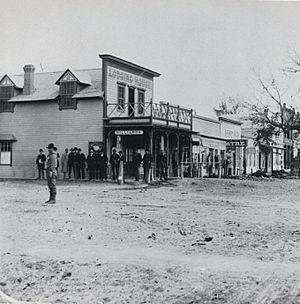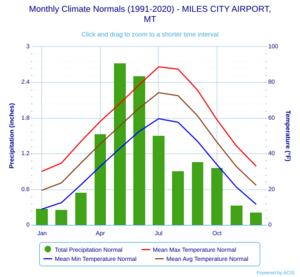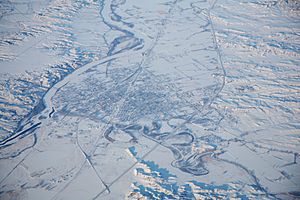Miles City, Montana facts for kids
Quick facts for kids
Miles City
|
|
|---|---|
|
City
|
|
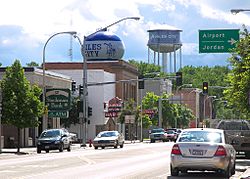
Main Street in Miles City
|
|
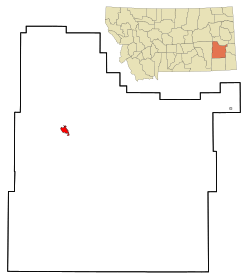
Location of Miles City, Montana
|
|
| Country | United States |
| State | Montana |
| County | Custer |
| Area | |
| • Total | 3.37 sq mi (8.72 km2) |
| • Land | 3.36 sq mi (8.71 km2) |
| • Water | 0.01 sq mi (0.01 km2) |
| Elevation | 2,362 ft (720 m) |
| Population
(2020)
|
|
| • Total | 8,354 |
| • Density | 2,484.83/sq mi (959.45/km2) |
| Time zone | UTC−7 (Mountain (MST)) |
| • Summer (DST) | UTC−6 (MDT) |
| ZIP code |
59301
|
| Area code(s) | 406 |
| FIPS code | 30-49525 |
| GNIS feature ID | 0774202 |
Miles City is a city in Montana, United States. It is the main city of Custer County. In 2020, about 8,354 people lived there.
Contents
History of Miles City
After a big battle in 1876, the U.S. Army built forts in eastern Montana. One of these forts was near where the Tongue River meets the Yellowstone River. This first fort was called Tongue River Cantonment.
Later, a new, stronger fort was built nearby. It was named Fort Keogh. It was named after Captain Myles Keogh, a soldier who died in the battle. His horse, Comanche, was the only survivor from his group.
General Nelson A. Miles commanded Fort Keogh. He helped bring peace to the area in the late 1800s. Early merchants who sold goods to the soldiers moved two miles east and started the first Miles City. People sometimes called it "Milestown." When the fort moved, the town moved too, to its current spot.
In the late 1880s, many cattle were brought to the open fields around Miles City. The railroad came through, making it easy to send cattle to other cities. This helped the town grow a lot.
Miles City officially became a town in 1887. Its first mayor was Eugene Henry "Skew" Johnson. Around the same time, Miles City started its own electric power company. This was a source of pride for the city.
Miles City grew quickly until the First World War (1914-1918). After that, another city called Billings grew much larger. Billings became a major center for banking, oil, and medical services in Montana.
The Miles City Municipal Airport is close to town. In 1939, an early passenger plane crash happened there, which was a sad event for the start of modern aviation.
Geography and Climate
Miles City is located in the High Plains area of the Great Plains. It sits between the Tongue and Yellowstone rivers. The city covers about 3.34 square miles (8.72 square kilometers) of land.
Interstate 94 goes through Miles City. You can get on or off the highway at Exits 135, 138, and 141. Montana Highway 59 also runs north and south through the area. The Tongue River flows into the Yellowstone River right at the town. Pirogue Island State Park is also very close by.
Climate in Miles City
Miles City has a cold semi-arid climate. This means it has dry weather, with cold winters and hot summers. It also holds a record for very high air pressure, which happened on December 24, 1983.
| Climate data for Miles City, Montana (Miles City Airport), 1991–2020 normals, extremes 1937–present | |||||||||||||
|---|---|---|---|---|---|---|---|---|---|---|---|---|---|
| Month | Jan | Feb | Mar | Apr | May | Jun | Jul | Aug | Sep | Oct | Nov | Dec | Year |
| Record high °F (°C) | 72 (22) |
73 (23) |
83 (28) |
92 (33) |
100 (38) |
111 (44) |
110 (43) |
110 (43) |
106 (41) |
95 (35) |
81 (27) |
70 (21) |
111 (44) |
| Mean maximum °F (°C) | 52.0 (11.1) |
55.8 (13.2) |
71.1 (21.7) |
80.8 (27.1) |
87.3 (30.7) |
96.4 (35.8) |
102.6 (39.2) |
100.8 (38.2) |
96.3 (35.7) |
83.6 (28.7) |
67.5 (19.7) |
53.9 (12.2) |
104.1 (40.1) |
| Mean daily maximum °F (°C) | 30.1 (−1.1) |
34.7 (1.5) |
46.8 (8.2) |
58.1 (14.5) |
68.1 (20.1) |
78.6 (25.9) |
88.7 (31.5) |
87.4 (30.8) |
75.6 (24.2) |
59.0 (15.0) |
44.3 (6.8) |
33.1 (0.6) |
58.7 (14.8) |
| Daily mean °F (°C) | 19.5 (−6.9) |
23.6 (−4.7) |
34.7 (1.5) |
45.5 (7.5) |
55.5 (13.1) |
65.6 (18.7) |
74.2 (23.4) |
72.5 (22.5) |
61.2 (16.2) |
46.4 (8.0) |
32.7 (0.4) |
22.4 (−5.3) |
46.1 (7.8) |
| Mean daily minimum °F (°C) | 8.9 (−12.8) |
12.5 (−10.8) |
22.5 (−5.3) |
32.9 (0.5) |
42.9 (6.1) |
52.5 (11.4) |
59.6 (15.3) |
57.6 (14.2) |
46.9 (8.3) |
33.8 (1.0) |
21.2 (−6.0) |
11.7 (−11.3) |
33.6 (0.9) |
| Mean minimum °F (°C) | −16.9 (−27.2) |
−8.7 (−22.6) |
1.2 (−17.1) |
18.1 (−7.7) |
29.5 (−1.4) |
42.3 (5.7) |
50.6 (10.3) |
45.9 (7.7) |
32.8 (0.4) |
17.7 (−7.9) |
−0.3 (−17.9) |
−11.3 (−24.1) |
−23.8 (−31.0) |
| Record low °F (°C) | −37 (−38) |
−37 (−38) |
−31 (−35) |
2 (−17) |
15 (−9) |
32 (0) |
41 (5) |
35 (2) |
19 (−7) |
−8 (−22) |
−25 (−32) |
−38 (−39) |
−38 (−39) |
| Average precipitation inches (mm) | 0.28 (7.1) |
0.26 (6.6) |
0.55 (14) |
1.54 (39) |
2.73 (69) |
2.51 (64) |
1.51 (38) |
0.91 (23) |
1.07 (27) |
0.97 (25) |
0.33 (8.4) |
0.22 (5.6) |
12.88 (327) |
| Average snowfall inches (cm) | 5.8 (15) |
3.7 (9.4) |
4.3 (11) |
4.1 (10) |
1.4 (3.6) |
0.0 (0.0) |
0.0 (0.0) |
0.0 (0.0) |
0.3 (0.76) |
1.0 (2.5) |
4.5 (11) |
4.4 (11) |
29.5 (75) |
| Average precipitation days (≥ 0.01 in) | 5.1 | 5.1 | 6.3 | 8.8 | 12.0 | 11.1 | 8.0 | 6.5 | 6.5 | 7.6 | 5.4 | 4.3 | 86.7 |
| Average snowy days (≥ 0.1 in) | 5.0 | 4.0 | 4.0 | 1.7 | 0.6 | 0.0 | 0.0 | 0.0 | 0.3 | 0.7 | 3.7 | 5.1 | 25.1 |
| Average relative humidity (%) | 71.7 | 72.4 | 67.5 | 58.4 | 57.5 | 55.2 | 46.8 | 45.4 | 54.4 | 59.5 | 69.4 | 73.0 | 60.9 |
| Average dew point °F (°C) | 7.9 (−13.4) |
14.7 (−9.6) |
22.1 (−5.5) |
29.5 (−1.4) |
39.6 (4.2) |
48.0 (8.9) |
50.2 (10.1) |
47.1 (8.4) |
40.1 (4.5) |
32.0 (0.0) |
21.4 (−5.9) |
11.8 (−11.2) |
30.4 (−0.9) |
| Source 1: National Weather Service | |||||||||||||
| Source 2: NOAA (relative humidity and dew point 1961–1990, average snowfall/snowy days 1981–2010) | |||||||||||||
People in Miles City
| Historical population | |||
|---|---|---|---|
| Census | Pop. | %± | |
| 1880 | 629 | — | |
| 1890 | 956 | 52.0% | |
| 1900 | 1,938 | 102.7% | |
| 1910 | 4,697 | 142.4% | |
| 1920 | 7,937 | 69.0% | |
| 1930 | 7,175 | −9.6% | |
| 1940 | 7,313 | 1.9% | |
| 1950 | 9,243 | 26.4% | |
| 1960 | 9,665 | 4.6% | |
| 1970 | 9,023 | −6.6% | |
| 1980 | 9,602 | 6.4% | |
| 1990 | 8,461 | −11.9% | |
| 2000 | 8,487 | 0.3% | |
| 2010 | 8,410 | −0.9% | |
| 2020 | 8,354 | −0.7% | |
| U.S. Decennial Census | |||
In 2010, there were 8,410 people living in Miles City. There were 3,677 households, and 2,082 families. About 27.5% of households had children under 18. Many households (42%) were married couples.
The average age in the city was 40.6 years old. About 22.4% of the people were under 18, and 17.8% were 65 or older.
Media and Events
Miles City has its own newspaper called The Miles City Star.
Radio Stations in Miles City
- KATL (AM 770) – Plays popular music
- KMTA (AM 1050) – Plays older music
- KIKC (AM 1250) – Plays older music
- KYPR (FM 90.7) – NPR station
- KYUS-FM (92.3 FM) – Plays adult hits
- KIKC-FM (101.3 FM) – Plays Country music
Miles City Events
In March 1944, a large ice jam on the Yellowstone River caused flooding in Miles City. The Army Air Corps helped by sending a B-17 bomber. It used bombs to break up the ice jam and stop the flooding.
The biggest event each year is the Miles City Bucking Horse Sale. It happens in May and is a huge gathering for people interested in horses and ranching. Miles City is also the main business center for southeastern Montana.
Education in Miles City
Miles Community College started in 1939. It has small class sizes, with about 11 students for every teacher. Most students can get financial help for their studies. The college also offers free tutoring to help students succeed.
Custer County District High School is the only high school in the entire county. Some students have to drive as far as 60 miles (97 km) to get to school! The high school started in the late 1880s. Many students are involved in agriculture or ranching, so the local National FFA Organization (Future Farmers of America) group is very active. The high school's musical Chorale group is famous and has traveled to places like Carnegie Hall in New York City.
Miles City also has several public schools for younger students:
- Lincoln (grades 3–6)
- Highland Park (grades K to 2)
- Jefferson (K to 2)
- Garfield (grades 1–6)
- Washington School (middle school for grades 7 and 8)
Washington Middle School offers many activities like sports and student council. There is also a private Roman Catholic school called Sacred Heart Parish School for pre-kindergarten through 8th grade.
The Miles City Public Library serves the area. It has a building and an online website with links to other libraries.
Places to See
The highest point nearby is Signal Butte, which is 3,051 feet (930 meters) above sea level. Native Americans may have used it for communication. It is now used for radio and TV antennas. Signal Butte is next to an area of badlands, which are dry lands with cool, colorful rock layers.
Other interesting spots include:
- Airport Hill: A raised area on the north side of the Yellowstone River.
- 12 Mile Dam: This dam on the Tongue River is a popular spot for water sports in the summer. The Tongue River is often used for tubing because it is shallow.
- Fort Keogh: This historic fort once had an Air Force radar station. It now has a state experiment station.
- Fish Hatchery: Near the highway, you can find a state fish hatchery.
- Camelback: A double-humped hill that looks like a camel's back.
Both the Tongue and Yellowstone rivers are popular for fishing. You can often catch catfish and carp there. Many local lakes are stocked with fish from the hatchery in Miles City.
Trinity Lutheran Church
Miles City has 21 places of worship. Trinity Lutheran Church was founded in 1906. It started with German services for settlers who came by the new Northern Pacific Railroad. Today, it is an English-speaking church. They also run Trinity Lutheran Classical School, which includes a Christian preschool and kindergarten through 8th grade.
Transportation
You can travel to Miles City by bus using Jefferson Lines service.
Notable People from Miles City
- Walter A. Burleigh: A delegate to the U.S. House of Representatives.
- Noelle E. Cockett: A geneticist and university president.
- Emily Danforth: A professor and author.
- Caleb Frare: A professional baseball pitcher.
- Maurice Hilleman: A famous microbiologist.
- Elmer Holt: The tenth governor of Montana.
- George Lynch: A race car driver.
- Jeff Meyer: A television director.
- Merle Greene Robertson: An art historian known for studying the ancient Maya civilization.
- Curt Schmidt: A pitcher for the Montreal Expos baseball team.
- James Arnold von der Heydt: A lawyer and judge.
- Larry R. Williams: A commodity trader and author. He is the father of actress Michelle Williams.
- George Winston: A pianist.
See also
 In Spanish: Miles City (Montana) para niños
In Spanish: Miles City (Montana) para niños


